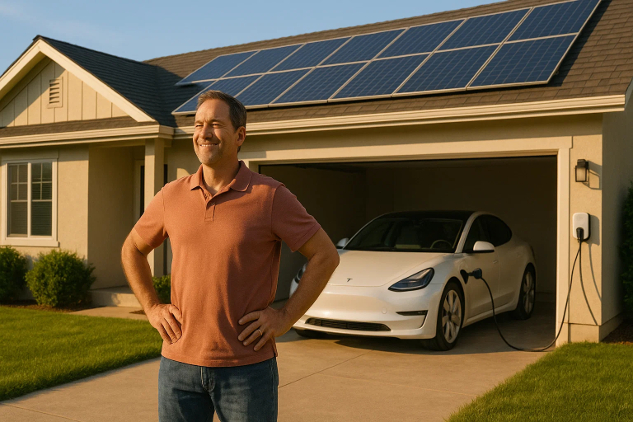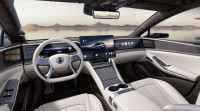
In This Article
- How did electric cars originate and evolve?
- What led to the decline and resurgence of EVs?
- How is Volvo leading in hybrid and electric vehicle innovations?
- What are the benefits of the Volvo XC90 T8 Plug-in Hybrid?
- How can home solar panels enhance EV charging efficiency?
Electric Car History to BYD's EV Revolution
by Robert Jennings, InnerSelf.comBefore Henry Ford flooded the streets with gas-guzzling Model Ts, electric vehicles were quietly making headlines. Electric cars were the vehicle of choice in the late 1800s and early 1900s, especially among the wealthy. They didn’t sputter, stall, or require a crank to start. They were clean, quiet, and surprisingly reliable. Even Clara Ford, Henry’s wife, preferred her electric runabout to her husband’s smelly gasoline contraptions.
By 1900, about one-third of all cars on American roads were electric. This historical fact is a reminder of the untapped potential of electric vehicles. Despite being buried in the past, they are now making a strong comeback. The birth of the internal combustion engine economy, fueled by Big Oil, may have pushed electric vehicles off the road, but it couldn't erase their potential. Now, they are back, and this time, they are here to revolutionize the automotive industry.
The Quiet Sabotage of a Cleaner Future
The 20th century was a long love affair with fossil fuels. Every time the electric car tried to make a comeback, it was strangled in its crib. General Motors’ infamous EV1 in the 1990s? Killed. Literally. Rounded up and crushed. The documentary Who Killed the Electric Car? barely scratches the surface. Oil executives, politicians, and even short-sighted carmakers conspired—sometimes subtly, brazen—to ensure gas stayed king.
Electric vehicles weren’t technologically inferior. They were politically inconvenient. After all, who wants a car that doesn’t require ExxonMobil’s weekly handshake? Or one that could be charged at home, off-grid, using solar panels—effectively cutting out entire industries? That kind of independence is dangerous to centralized power.
The sabotage didn’t stop with personal vehicles. In the mid-20th century, electric streetcars and trolleybuses—once the backbone of clean, efficient public transit in cities across America—were systematically dismantled. A consortium led by General Motors, Firestone Tire, and Standard Oil quietly bought dozens of streetcar systems through front companies to rip up the tracks and replace them with gas-powered buses. It wasn’t progress—it was a hostile takeover. Public transportation was reshaped not to serve people but to serve petroleum. The result? More cars, roads, smog—and a century of missed opportunities for clean, shared mobility.
The Renaissance: From Tesla to Today
Fast-forward to the 21st century. The climate is boiling, the polar ice caps are melting, and finally, people are waking up. Enter Elon Musk and Tesla. Whatever you think of the man (and I have thoughts), he cracked the armor. Tesla made electric cars not just viable but sexy. Acceleration times, futuristic dashboards, over-the-air software updates—suddenly, driving electric was aspirational.
Now, nearly every automaker has scrambled to catch up. But not all brands were late to the game. Some, like Volvo, have taken a more thoughtful, calculated approach: less hype, more substance, fewer buzzwords, more innovation. Volvo didn’t just pivot—it evolved.
BYD Is Turning the EV Market Upside Down
While Western automakers were busy patting themselves on the back for incremental EV progress, BYD was quietly building an empire. In 2024, the Chinese automaker sold over 4.3 million vehicles globally—a staggering 41% increase from the previous year—surpassing Tesla in total EV sales and net income. BYD's secret sauce? Vertical integration, a strategy where a company controls all aspects of production, from raw materials to the finished product. By manufacturing its own batteries, semiconductors, and even vehicle molds, BYD slashes costs and accelerates innovation, leaving competitors scrambling to keep up.
Take the BYD Seagull, for instance. This subcompact EV, priced at a jaw-dropping $7,770, isn't just affordable—it's a statement. With features like Level 2 driver-assist systems and a range that suits urban commuters, the Seagull has become a symbol of BYD's disruptive approach. In April 2025, BYD outsold Tesla in Europe for the first time, registering 7,231 battery-electric vehicles compared to Tesla's 7,165. This isn't just a blip; it's a seismic shift in the automotive landscape.
But BYD's ambitions don't stop at sales figures. The company aims to sell half its vehicles outside China by 2030, with aggressive expansions into Europe, Southeast Asia, and Latin America. Its recent price cuts—up to 34% on specific models—have sparked a price war in China, pressuring competitors and reshaping global EV pricing strategies. BYD isn't just participating in the EV revolution; it's leading it.
The 100% Tariff: A Misguided Attempt to Halt Progress
In a move that reeks of protectionism, the U.S. government imposed a 100% tariff on Chinese-made electric vehicles in 2024. The rationale? To shield domestic automakers from the onslaught of affordable, high-quality EVs flooding in from China. But let's call this what it is: a Band-Aid on a bullet wound. Instead of fostering innovation and competitiveness, the tariff penalizes consumers and stalls progress.
History has shown that tariffs rarely achieve their intended goals. They often lead to higher consumer prices and retaliatory measures from trade partners. In this case, the tariff effectively doubles the cost of Chinese EVs, making them inaccessible to the average American consumer. Meanwhile, domestic automakers continue to lag, unable to match the efficiency and affordability of companies like BYD.
Rather than erecting trade barriers, the U.S. should focus on bolstering its own EV industry. This means investing in research and development, streamlining regulations, and providing incentives for consumers and manufacturers. A ten-year subsidy program, gradually decreasing over time, could give domestic automakers the runway they need to innovate and compete globally. It's not about shielding ourselves from competition; it's about rising to meet it. Such a program could stimulate innovation, create jobs, and position the U.S. as a leader in the global EV market.
Lynk & Co 08: A Hybrid Worth Paying Attention To
Most plug-in hybrids have felt like half-baked compromises—gas cars in green clothing. But the Lynk & Co 08 is different. With an electric-only range of 200 kilometers (124 miles) and DC fast charging that takes the battery from 10% to 80% in just 33 minutes, it’s the first plug-in hybrid that feels like it leads with electricity, not fossil fuel. These innovative features make the 08 a hybrid worth paying attention to, sparking curiosity and interest in its potential.
Set to debut in Europe in June 2025, the 08 offers more electric range than any other European PHEV. It finally makes it possible for average drivers to do almost all their daily driving on electricity while still keeping a gas engine as a backup. That’s not a gimmick—it’s a strategic design choice to make EV life feel normal, not experimental.
Yes, plug-in hybrids have drawn criticism—especially in Europe—where generous subsidies encouraged drivers to buy them without using their electric modes. But the 08 challenges that bad habit. With this much electric range, drivers are naturally encouraged to plug in rather than gas up.
In many ways, this is the perfect stepping-stone vehicle. For folks nervous about range limits or poor charging infrastructure, the 08 provides peace of mind without sacrificing clean driving. It's not a forever solution—but it could be a gateway to fully electric living.
Lynk & Co. says the 08 is a “game-changer.” For once, they might be right. If policy shifts toward rewarding actual electric use—not just hybrid badges—we might see more of these transition vehicles helping nudge the world out of the fossil age, one commute at a time.
Charging at Home: The True Energy Revolution
But let’s not stop at the car. The real game-changer is what happens at home. Picture this: your XC90 T8 parked in the driveway, quietly sipping electricity from rooftop solar panels. No gas station stops. No utility bills. Just clean, autonomous energy drawn from the sky. Sounds utopian? It's not. It's a reality—for those who invest in solar EV charging.
Solar-powered home charging isn’t a novelty—it’s a declaration of independence. It means you're no longer at the mercy of gas prices or grid blackouts. It means your car and home form a self-sustaining ecosystem, an energy loop that thumbs its nose at Exxon and applauds the sun.
Solar panels have never been cheaper, more efficient, or more accessible. Government incentives still exist (though who knows for how long), and the return on investment is fast. When you factor in fuel savings, tax credits, and the long-term value of energy independence, the numbers write their own case.
What the Oil Industry Doesn’t Want You to Know
This is where the conversation turns. The reason electric cars—and especially solar charging—are so powerful isn’t just environmental. It’s economic. They decentralize power—literally and figuratively. You stop being a customer and become a producer. That terrifies legacy industries.
Every mile you drive on solar power is not bought from Shell, Chevron, or BP. Every rooftop panel is a mini-revolution. When you charge at home, you take back control from oil companies, utility monopolies, and predatory middlemen. It's not just greener. It's smarter.
The Road Ahead: Clean, Silent, Solar
We’re standing at the intersection of past mistakes and future possibilities. The electric car isn’t new. It’s finally being given the respect and infrastructure it deserved all along. And in Volvo’s quiet, measured way, they’ve emerged not as flashy disruptors but as sustainable innovators.
When your car charges while the sun shines and drives with barely a whisper, it’s not just a transportation upgrade—it’s a mindset shift. We stop being passive consumers and become intentional participants in our energy future.
The transition won’t be perfect. There will be resistance, misinformation, and corporate sabotage. But the tide is turning. Solar rooftops are multiplying. Charging stations are spreading. The air is getting cleaner. And yes, the electric car is no longer an endangered species. It’s a rising force; this time, it’s not backing down.
So next time someone scoffs at your EV or questions the viability of solar power, remind them: this isn’t the future. This is the comeback. And it’s driving in the sunshine.
About the Author
 Robert Jennings is the co-publisher of InnerSelf.com, a platform dedicated to empowering individuals and fostering a more connected, equitable world. A veteran of the U.S. Marine Corps and the U.S. Army, Robert draws on his diverse life experiences, from working in real estate and construction to building InnerSelf with his wife, Marie T. Russell, to bring a practical, grounded perspective to life’s challenges. Founded in 1996, InnerSelf.com shares insights to help people make informed, meaningful choices for themselves and the planet. More than 30 years later, InnerSelf continues to inspire clarity and empowerment.
Robert Jennings is the co-publisher of InnerSelf.com, a platform dedicated to empowering individuals and fostering a more connected, equitable world. A veteran of the U.S. Marine Corps and the U.S. Army, Robert draws on his diverse life experiences, from working in real estate and construction to building InnerSelf with his wife, Marie T. Russell, to bring a practical, grounded perspective to life’s challenges. Founded in 1996, InnerSelf.com shares insights to help people make informed, meaningful choices for themselves and the planet. More than 30 years later, InnerSelf continues to inspire clarity and empowerment.
Creative Commons 4.0
This article is licensed under a Creative Commons Attribution-Share Alike 4.0 License. Attribute the author Robert Jennings, InnerSelf.com. Link back to the article This article originally appeared on InnerSelf.com
Article Recap
This article explores the long and often buried history of electric cars, tracing their roots from the 1800s to their modern rebirth. It highlights Volvo’s XC90 T8 plug-in hybrid as a practical solution in the current EV landscape and emphasizes how home solar charging completes the clean energy loop. Together, they offer a sustainable and empowering path forward for drivers tired of oil dependency.
#ElectricCarHistory #VolvoHybridEV #HomeSolarCharging #EVEvolution #SustainableDriving



